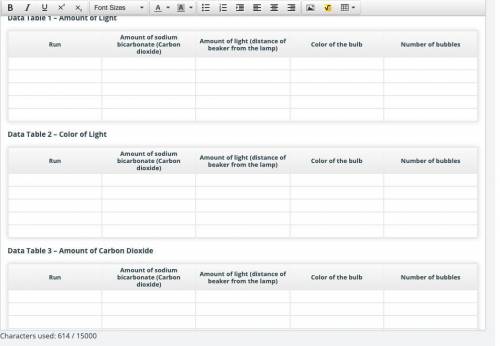
Biology, 13.10.2020 08:01, sheilaaguilar2014
Cell Structure and Function
Plants produce oxygen during the process of photosynthesis. This oxygen can be measured by counting the number of bubbles produced by the plant for a particular time period. Different factors like the color of light, amount of light, and the amount of carbon dioxide affect the rate of photosynthesis.
In this activity, you will deepen your understanding of the process of photosynthesis, and investigate factors that affect the rate of photosynthesis.
Here are some of the links that you can refer to before starting with the activity:
Light reactions of photosynthesis
Calvin cycle
Light reactions and Calvin cycle
For this investigation gather items shown in the list.
() You’ll need the following materials:
a beaker (500 ml)
a pondweed like Elodea
an electric lamp, and different colored bulbs (blue, green, red, and white)
a pair of scissors
a ruler
colored filters
a stop-watch or a timer
sodium bicarbonate (baking soda) in a small petri dish
Part A: Experimental Design
Question 1
Before beginning your experiments, make a hypothesis for the following variables:
Hypothesis 1: Amount of Light
Hypothesis 2: Color of Light
Hypothesis 3: Amount of Carbon Dioxide
Question 2
Now, test your hypothesis from Part A and fill in the data tables below for each hypothesis test. Gather all the materials and perform the steps given below.
A. Fill water in the beaker up to the 250 ml mark. Cut the end of the pondweed using scissors and immerse the plant in the beaker.
B. Keep the stop watch set to zero near the beaker and set up the entire apparatus inside a dark room.
C. Hypothesis 1: Amount of light: To test the effect of intensity (amount) of light on the process of photosynthesis follow the given steps:
1) Increase the distance of the beaker from the lamp by keeping the beaker at 5 cm, 8 cm, 11 cm, and 14 cm away from the lamp.
2) Keep the amount of carbon dioxide constant in the beaker by adding a pinch of sodium bicarbonate.
3) Allow the light from the lamp to fall on the beaker, reset the stop watch and start it again.
4) Count the number of bubbles released in the beaker after two minutes and note it down in the table.
5) Repeat the process for all the other colored lamps.
D. Hypothesis 2: Color of light: To test the effect of different colored lights on the process of photosynthesis follow the given steps:
1) Keep the beaker containing the pondweed at a distance of 5 cm from the lamp. Measure the distance using the ruler.
2) Add a pinch of sodium bicarbonate in the beaker to keep the amount of carbon dioxide constant (Sodium bicarbonate reacts with water to give carbon dioxide.)
3) Use the white bulb in the lamp and allow the light from the lamp to fall on the beaker and start the stop watch.
4) Count the number of bubbles released in the beaker after two minutes and note it down in the table.
5) Repeat the procedure with the other colored light-bulbs, while maintaining the same distance between the beaker and the lamp as with the white bulb.
E. Hypothesis 3: Amounts of Carbon dioxide: To test the effect of varying amounts of carbon dioxide on the process of photosynthesis follow the given steps:
1) Keep the beaker at a distance of 5 cm from the lamp and add a pinch of sodium bicarbonate.
2) Use the white bulb in the lamp and allow the light from the lamp to fall on the beaker, reset the stop watch and start it again.
3) Count the number of bubbles released in the beaker after two minutes and note it down in the table.
4) Increase the amount of sodium bicarbonate by adding 2 pinches, 3 pinches, and 4 pinches and count the number of bubbles released each time after a duration of two minutes.
( TABLE IN PICTURE )
Part 2: Analysis
Write your responses for each of the questions below, based on observations from testing your hypotheses.
Question 1
During which phase of photosynthesis is light used? Summarize these reactions in a paragraph.
Question 2
During which phase of photosynthesis is carbon dioxide used?Summarize these reactions in a paragraph.
Question 3
If your greenhouse was built in the desert southwest, many plants would use a different pathway for photosynthesis. Describe the C4 pathway.
Font Sizes
Characters used: 0 / 15000
Part C: Conclusion
Identify whether each of your hypotheses were supported or not. Use data to justify your answer.


Answers: 2
Other questions on the subject: Biology


Biology, 22.06.2019 04:00, isabellesmith51317
Indicate the coat color and the proportion of offspring with that color for each of the following crosses of rabbits. assume all are homozygous. agouti x albino a) 1/2 albino, 1/2 agouti b) all agouti c) 3/4 agouti, 1/4 albino
Answers: 2

Biology, 22.06.2019 10:30, talanna394
Hershey and chase confirmed that dna, not protein, was the genetic material. how do the results of their two experiments support this conclusion?
Answers: 3
Do you know the correct answer?
Cell Structure and Function
Plants produce oxygen during the process of photosynthesis. This oxygen...
Questions in other subjects:




History, 26.06.2020 21:01






Mathematics, 26.06.2020 21:01






